Gardeners every new season is trying to find new beautiful and bright flowers that will fit in a landscape design. Some choose all familiar local cultures, while others prefer exotic and spectacular flowering plants. It is to such a hibiscus - a bright and truly colorful and unforgettable flower, the huge inflorescences of which will not leave anyone indifferent. Hibiscus is a grassy or Chinese rose - one of the most popular representatives of this kind, which firmly arrived in garden sites. Today, there are a large number of hibiscus gibyskis varieties, which are distinguished by the most different colors of inflorescences and the height of the bush. Therefore, many flower products choose this exotic handsome man for their inadlines.
To grow huge flowers on its plot, it is important to know all the important features and nuances. Therefore, in this article, consider the description of the hibiscus of grassy, \u200b\u200bwe present the characteristics of the most popular varieties of this culture. We note the important rules for growing hibiscus grassy.
Features and description of hibiscus herbaceous
Hibiscus is a deciduous evergreen plant, which is the most vivid representative of the Malvian family. The generation of this culture can be represented by grassy, \u200b\u200btree and shrub shapes, which allows gardeners to create bright garden compositions with their use. The natural habitat of all colors of hibiscus is considered the territory of a new and old light with a tropical and subtropical climate. In Europe, Hibiscus appeared in the 19th century, and acquired the greatest popularity in the 20th century, when the varieties of this plant began to grow at home in vases. Hibiscus cultivation in a moderate climate is quite problematic, with the exception of herbic hibiscus or hybrid.
Hibiscus Herbaceous has North American roots. It was obtained in the 40-50s due to the work of the United States breeders. They crossed the three types of hibiscus: marsh, red or ostolistic. As a result, a variety of hybrid hibiscus was obtained, which includes a huge variety of varieties.
Perhaps some gardeners do not have the idea of \u200b\u200bthe existence of such a plant as hibiscus. However, it is worth mentioning the Flower "Chinese Rose", immediately becomes clear what is in question. After all, it is the Chinese rose who loved Russian flower flowers as a room flower. Herbaceous Hibiscus has more spectacular characteristics and the possibility of growing in the open ground in a moderate climate. Hybiscus Hybrid or Hibiscus Garden is the name of hibiscus herbaceous, which are also often used in everyday life of true connoisseurs of this culture.
Hibiscus Description Herbaceous:
- Hibiscus is grassy is a long-term or annual flower, which is a representative of the kind of hibiscus and the Malvian family.
- This type of hibiscus has a number of distinctive features, among which the feature of the upper part of the plants is distinguished to die each autumn. At the same time, all nutrients go to the root system, allowing it to withstand winter frosts.
- The root hibiscus hibiscus system is quite powerful and is located deeply, it is dense and well developed. The roots can be located at a depth of 20 to 40 cm. In appearance resembles modified elongated potatoes, so such a root system can be called a tuber.
- Rhizome is very varying, with the slightest damage, the entire bush may die. Therefore, after removing the above-ground part of the plants, it is recommended to note the location of the root system to the sign so that it is accidentally damaged.
- Hibiscus Herbaceous is a scattered and massive shrub, which can be 100-300 cm in height. At the same time, the kestic diameter is also quite impressive, it can be 1.5-2 meters.
- The bustice is formed by a large number of thin and strong shoots that have time to grow in one season. Stems upright, have a bright yellowish green shade.
- The stalks of the plant die in the fall, then the next season grows again.
- Herbaceous Hibiscus, in contrast to the tree, is less covered with foliage, but despite this, the bush has a fairly magnificent crown. Leaves have an oblong shape with something like a leaf of birch or sunflower.
- The foliage has a pointed form, slightly outcropped, saw. The leaves on short stiffs are attached, the length of the leaves themselves can be approximately 6-7 cm.
- Sheet plate is shiny and glossy, light or dark green, it all depends on the specific grade of hibiscus herbaceous.
- The most importantly decoration of this type of hibiscus is beautiful and just huge inflorescences. The tree and shrub species have a much smaller sizes, which is why many flower trees prefer hibiscus herbaceous.
- Flowers have a funnel shape, sometimes bell tulip or tulip. Stamens and pestle can strongly perform from the central part of the flower.
- Amazing the imagination is a large variety of colors coloring: white, yellow, orange, red, pink, lilap, purple, purple, raspberry, blue. There are also flowers with contrasting color, where the middle of the inflorescence and the edges have different shades.
- Hibiscus grassy flowers also have a different structure. Eliminate varieties with simple colors, terry, semi-world, corrugated. At the same time, in a temperate climate, it is recommended to grow varieties with simple colors.
- Inflorescences have very large sizes, in diameter one flower can reach 10-40 cm.
- This plant has a very unusual feature: one flower lives just a day, after which he dies. However, another flower blooms on his replacement.
- Flowering in the southern regions begins approximately in May, in more northern areas, bloom can begin only at the beginning or middle of July. Hibiscus flowers grassy long time than also differs from other representatives of the genus. Beautiful and bright inflorescences can appear to the first frost.
- This plant is fruit. After biting inflorescences on the stems, fruits appear in the form of five-man boxes, in which seeds ripen.
- Hibisci grassy winter-hardy plants can perfectly endure the harsh winter of the middle strip of Russia. At the same time, the upper part dies, and the root system holds to the spring itself.
- Exotic plants are used by gardeners for various garden compositions. Higher varieties are well suited for single landings or to create a background with other plants. Little hibiscus grassy can be used as border crops.
A variety of hibiscus gravist varieties
To date, the breeders are derived a large number of various varieties of hibiscus of grassy, \u200b\u200bwhich have bright colors of inflorescences, sizes of colors and height of cookies. Thanks to an extensive assortment of new modern culture varieties, it is possible to create bright and unusual garden compositions. Consider the characteristics of the most popular Hibiscus varieties of grassy.
- Hibiscus grade "Youth". One of the most popular varieties of culture, which is distinguished by average growth. Bucket shoots in height can reach 1.5 meters as much as possible. The bush branches weakly, shoots differ in a light tint. Side brans depart from major major shoots. The leaves of the "Youth" grade have an oblong shape, three- or five-party. Sheet plate shiny, light green shade. The flower has a beautiful tulip shape. Petals of a gentle pink shade, a middle of a flower or a bottom painted in white. In diameter, one flower is approximately 10 cm. The variety is characterized by excellent frost resistance and unpretentiousness in care.
- Hibiscus gravist "Late". It is a low compact bush, which in height can reach about 80-100 cm. The plant diameter is also no more than 1 meter. This variety is ideal for the framing of garden tracks and borders. For the season, many strong and powerful shoots are formed, which are thickly covered with foliage. The leaves of oval-sweat-shaped shape, gear, on the surface are yellowish thick veins. Painted leaves with strong stuffs. Flowers of this variety are small, in diameter can reach 7 cm. Pleased with a bright raspberry-pink shade with a lilac shade.
- Hybiscus gravy pale pink grade. It is an herbaceous shrub, which can be in height to reach about 170-200 cm. From the main stems, short shoots are departed at a small angle. The grade is very covered with foliage. The leaves are three-party, with a gear edge, a leaf plate is yellowish-green with well distinguishable veins. The flowers of the pale pink variety of hibiscus grassy are similar in shape on tulips, in diameter can reach 10-12 cm. Inflorescences have a gentle pink tinge of petals and white color of the bowl.
- Hybiscus Grass Pink Hybiscus Grade. Highly branched low bustice, in height reaching about 130-150 cm. Saving strong and powerful, yellowish green shade. The leaves are oblong, strongly outcropped, with a distinctly serving middle part of the sheet plate. Color leaves dull yellow-green. Flowers of the bell-shaped shape, in diameter can reach about 12 cm. Sustained pink with a small yellowish tinge and white bottom are blooming.
- Grass hibiscus "Copper King". It is a compact bush with a rounded crown form. In height, the plant can maximize 120 cm. The leaves of this variety are large enough, openwork, in shape resemble maple leaves. A sheet plate of a dark green shade, which may vary depending on weather conditions. Hibiscus "Copper King" surprises flowerflowers with large and bright inflorescences, which in diameter can reach about 25-30 cm. Inflorescences are characterized by a gentle pink shade with dark pink streaks on the petals. A middle of a flower or its bottom painted into a dark red color. The grade has good resistance to diseases and frost.
- Variety "Krenberry Krash". This variety is great for the decoration of borders, as it is a compact bushing with a height of 90-120 cm. It has a neat round shape of the crown. The plant is well branching, foliage appears along the entire length of shoots from the earth itself. Leaves are oblong, slightly cake, a dark green shade with purple streants along the entire length. Flowers are large up to 25 cm in diameter, have a bright burgundy shade.
- Hibiscus grade grassy "Old Yell". Beautiful compact bush, height reaching 100-120 cm. The bush is formed by a large number of strong and powerful shoots with landscaping from the roots. Cell-shaped leaves, resemble a maple leaf, a green shade with a purple tide. Flowers are very large up to 30 cm in diameter, snow-white shade with red middle.
Gibiscus reproduction of grassy: the most common ways
Beautiful and spectacular hibiscus flowers of grassy can no problem grow in their plot. This plant pleases the flower ones unpretentious in leaving and rapid growth. And when complying with all reproduction rules, you can get healthy and full-fledged bushes that will delight flowering every year. Consider the characteristics and main points in the popular methods of the gibiscus of grassy.
Seed reproduction of hibiscus herbaceous
- Hibiscus herbaceous of seeds multiplies much more often than other varieties of culture. However, it is important to remember that in the end you can not always get the original appearance of plants. Most often from seeds you can get a completely new hibiscus grade with another shade of inflorescences. Flowers use this method to replenish their collection with a new instance.
- First of all, it is necessary to remember that only stratified seeds are used for sowing. After their collection in the autumn period, it is important to prepare a small container and fill it with a soil mixture consisting of sand and peat. Next, the surface of the soil is thoroughly moistened and seeds scatter. From above, planting material is a bit poured soil.
- The container is placed in the refrigerator for about 1-2 months.
- After the stratification process, it is important to clearly comply with the selection sequence to sow.
- First of all, the seeds are necessary for 10-12 hours to soak in the growth stimulatory solution, for example, in epine. After that, they are laid out on a paper towel, wrapped in a film and leave in the warm room for germination. It is important to regularly venture and moisturize the seeds.
- The first seed sprouts appear in about 5-7 days.
- After that, the seeds are planted into a greenhouse on the garden or in plastic cups one by one. If planted in a greenhouse, then crops are important to cover the agrofiber.
- For successful germination of seeds, it is necessary to maintain a temperature of 25-27 degrees.
- After about 1-2 weeks, shoots appear. At this time, they can be transplanted into large pots or permanent place. In this case, the plant will bloom only after 2-3 years.
- When landing seedlings a month after germination, the hibiscus seedlings are trampled faster.
Hybiscus grazing reproduction
- The reproduction of the extension method is used more often, as it makes it possible to quickly get planting material.
- Usually, the shilling of hibiscus herbaceous occurs at the beginning of summer. To do this, with adult bustle, it is necessary to cut small cuttings with a length of 10-15 cm. The cuttings are harvested from the tops of young shoots.
- It is important to comply with one rule - there should be 2-3 interstices on each cutlets.
- After the billet of the planting material, it is placed in a solution of the root former for accelerating the appearance of the roots.
- The cuttings can be rooted in pots, filled with a nutrient soil mixture or in greenhouses with lower heated.
- Some gardeners root the cuttings in the water tank until the appearance of the roots.
- Typically, the first roots appear in a month, after which young seedlings transplant or permanently in open ground, or in a pot with soil mixture for rearing.
- When a bustice is formed from a small plant, young hibiscus is grassy can be planted for a garden. In this case, the plant can be blooming in the same year.
Gibiscus reproduction of a herbaceous division of a bush
- Some gardeners and flowers prefer to multiply Hibiscus herbaceous with the help of a fashion division method. This option is considered the easiest, while it allows you to fully preserve the maternal signs of the plant.
- It is necessary to carry out the division of the bush only in spring and only on adult bush.
- For this, early in the morning or in cloudy weather, an adult plant is gently digging with a shovel. Next, it is important to gently smooth the root system from the soil, while trying not to damage the main roots.
- For separation, you can take a secateur or knife. You need to share in such a way as to cut only young roots.
- After division, it is imperative to handle sections with charcoal to prevent the posting.
- Dellets are immediately transplanted at a permanent place. It is important immediately after landing to pour young plants with warm water.
Hibiscus landing grassy
The cultivation of hibiscus is grassy on its plot for each gardener. However, to get a healthy and beautifully flowering plant is possible only with proper and competent preparation and landing in open ground.
Stage 1. Selection and purchase of hibiscus landing material Herbaceous
- First of all, it is necessary to take care of the purchase of high-quality planting material. It can be grown independently using one of the above breeding methods.
- If you do not have the ability to breed a plant, you can buy hibiscus grassy in any specialized store.
- Before buying, be sure to decide with the place of purchase of seedlings. From this will depend on the further growth of the bustle. Give preference to garden shops or nurseries that are professionally engaged in growing plants. Here you can buy not only high-quality seedlings, but also get professional advice.
- In stores most often sell seedlings in containers that allow landing full-fledged young plants to a permanent place.
- When choosing a hibiscus seedlings, pay attention to a specific variety. Terry or corrugated plants feel bad in the northern regions.
- Before buying, be sure to check the state of the seedlings you choose. They should not be visible damage, traces of rotting and yellowed plots. Soil in the container should be clean and moistened.
Stage 2. Choosing a place for landing hibiscus herbaceous
- From the correctly selected landing place will depend on the full development of hibiscus, its bloom and growth duration. If it is responsible to approach this issue, Hibiscus is grassy in one place can grow over 20 years.
- This plant prefers to grow on a plot where sunlight is present about 6 hours a day.
- You can land seedlings in open solar sites, but in this case it is important to increase the amount of irrigation.
- A landing of seedlings in a light half, but it should be borne in mind that there will be no flowering in the complete shadow.
- The selected area must necessarily be on a small elevation and with good drainage, since the presence of water from the roots causes them to bother.
- It is also important to place a hibiscus seedlock grassy in a place-protected place, since a plant can perish from a strong wind.
Stage 3. Choosing and soil preparation for hibiscus herbaceous
- Hibiscus is grassy is a plant that does not differ in great demanding to the soil.
- This plant can perfectly grow in a subline, turf or leaf soil.
- It is important to take into account that the soil in the selected area should be moisture-permeable and did not delay water.
- Hibiscus of this species can even grow on poor soils, but in this case it is important to carry out frequent feeding.
- Before boarding, the selected area is carefully loosen about 2 bayonet shovels, since the root system is located deep enough. It is important to remove all weeds and trash.
- To improve the composition of the soil, you can make river sand, peat and overwhelmed manure.
Stage 4. Gibiscus landing technology grassy
- Hibiscus is grassy in open soil planting early in the spring after the threat of return freezers.
- At a pre-prepared area, it is necessary to prepare landing pits. Their size should be greater than the container in which a young seedling grew. If you sit at once a few seedlings, then be sure to permanently permanently with a diameter of 1-1.5 meters.
- At the bottom of each pit, it is important to place the drainage layer about 15 cm. Small stones or gravel, broken brick can be used as a drainage. This layer will protect the plant from the stagnation of moisture.
- Next to the soil mixture, duck up from the pit, add humid, peat and sand.
- Before planting the soil in the container, it is thoroughly watered, and then career carefully remove.
- Saplings together with an earthen room in landing points are placed in such a way that the root neck is slightly underground. After that, the plants are sprinkled with soil.
- After landing, the priority circle must be meditated to avoid excessive evaporation of moisture and soil overheating.
Hybiscus Hybiscus Great Agrotechnology: Secrets and Nuances of Care
Care for hibiscus herbalist does not constitute special difficulties provided that it is planted correctly. It is important to pay attention to the plant and comply with the basic rules of agrotechnology of cultivation.
- Watering. Soil moisturizing is an important stage of care for this plant. Hibiscus requires frequent, but at the same time temperate irrigation, which increase in summer hot time and reduce to autumn. You can navigate to the upper word of the soil - if it is dried, you can water. If a dry period is sufficiently long, then you have to water every day. In hot weather it is also necessary to spray bushes, but you can do it only in the evening.
- Loosening and mulching. It is important to regularly remove all weeds in the rolling collar and loosen the top layer of the soil. This increases the aeration of the soil and its moisture permeability. Regularly you need to update the layer of mulch. To do this, you can use peat, sawdust or fir needles.
- Podchar. In an active period of vegetation, it is recommended to make a fertilizer plant with a large content of nitrogen and phosphorus. And in the fall before preparation for winter add fertilizer with potassium content. It is necessary to fear about twice a month. You can also use the organic.
- Hibiscus trimming grassy. It is important to regularly carry out sanitary trimming, during which all broken, damaged shoots are removed. To get lush and abundant flowering, it is important to trim shoots on 2/3. In moderate latitudes, pruning completely all shoots before the winter onset.
- Preparation for winter. Hibiscus is estimated by a frost-resistant plant, but in the northern regions after trimming the shoots, it is still recommended to cover the root system with a noodle or foliage.
Hibiscus grassy - Photo
Hibiscus is grassy - an exotic handsome man who will become an excellent decoration of any site. Thanks to excellent frost and unpretentiousness in care. The cultivation of this culture will not cause special difficulties, but will bring a sea of \u200b\u200bpositive emotions from contemplation of bright and colorful colors.

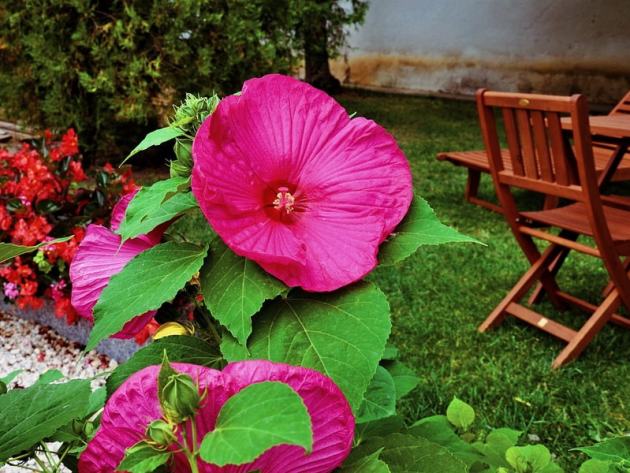

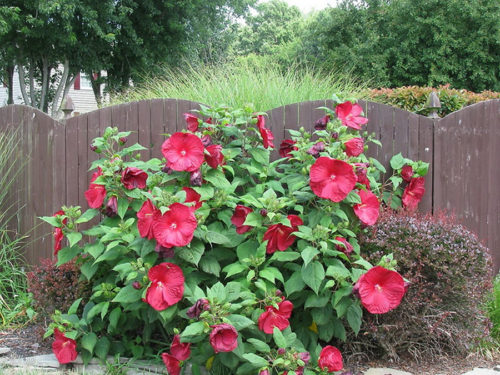



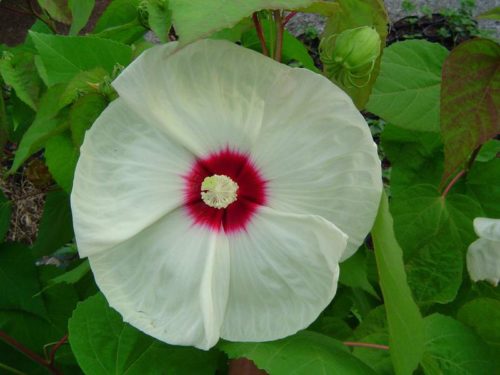
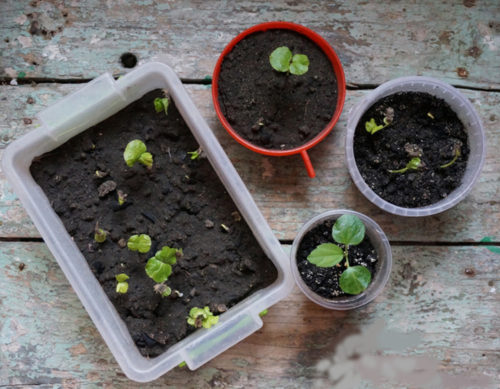
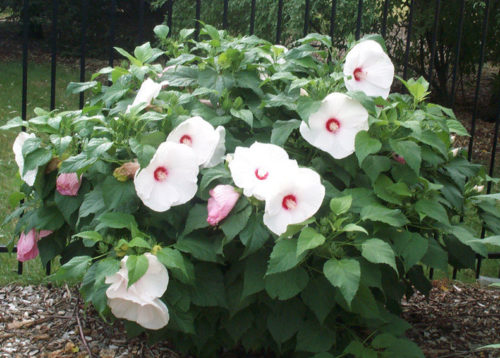


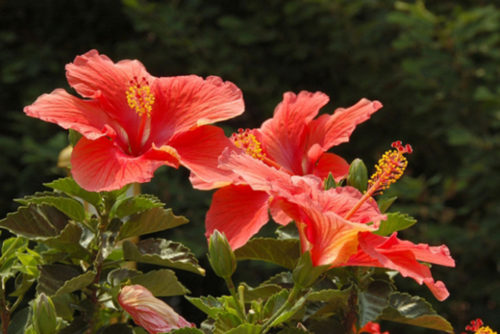


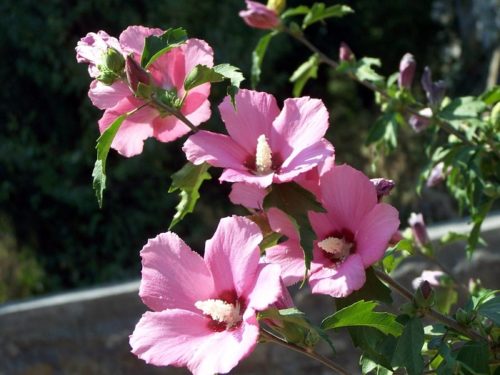













 Start a discussion ...
Start a discussion ...